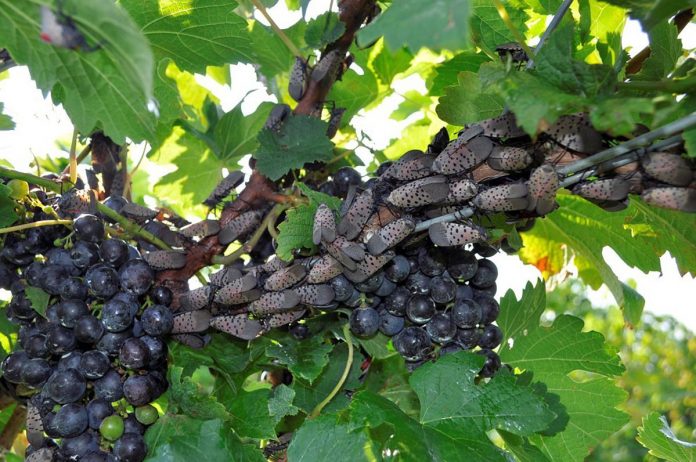A nightmare that Pennsylvania residents face every day may be coming to Ohio very soon.
The spotted lanternfly (SLF) is an invasive planthopper native to Asia that feeds on the sap of nearly every hardwood including black walnut, hard maple, tulip poplar and black cherry. They also love fruit.
Orchards, hop yards and vineyards in Pennsylvania have been crushed by this insect. SLF has been reported on numerous occasions to feed on corn and soybeans as well.
Honeydew sap. When this insect feeds, it opens the plant up for infection. It then excretes some of the sap it cannot digest in the form of a carbohydrate-rich liquid called honeydew.
Tens of thousands of SLF in a tree excreting honeydew can make it seem like it’s raining. The honeydew sticks to leaves, bark, the forest floor, and everything else it touches. Because it is high in sugar, black sooty mood forms on the honeydew which blocks sunlight from reaching the leaves, preventing photosynthesis from occurring. This sugary liquid covering the forest floor also attracts stinging insects such as yellow jackets which can make outdoor recreation miserable.
Confirmed in Pennsylvania. Spotted lanternfly was recently confirmed in Beaver and Allegheny counties, in Pennsylvania, directly across the border from Columbiana County, in Ohio.
This pest is thought to have arrived in Pennsylvania in the form of egg masses in 2012, presumably hitching a ride on a stone shipment. The first confirmed infestation of SLF was found in a grove of Tree of Heaven in Berks County, Pennsylvania, about 50 miles Northeast of Philadelphia.
Quarantine
It has since ravaged the agricultural and timber industries of that region, forcing Pennsylvania State officials to put a quarantine effort in place for affected counties. This quarantine requires a permit for commerce, camping or any other business moving in and out of the areas with known SLF infestations.
The permit is received after an educational course is taken on how to prevent the spread of SLF, i.e. using local firewood and checking vehicles and tools for egg masses before traveling. Despite the quarantine, there have now been four states with infestations and four more additional states with sightings, all within the New England and East coast areas.
According to a report by Penn State, SLF has cost the Pennsylvania economy 50 million dollars and 500 lost jobs every year since its arrival.
The problem with controlling the spread of SLF is that the egg clusters are camouflaged and difficult to notice as they look like a smear of mud or wax. Eggs can be laid on any smooth surface, and they often hitchhike on vehicles.
Tree of Heaven
This is a concerning trait for any invasive species, but in this case it is especially concerning because the host plant of the SLF is the Tree of Heaven, which frequently grows along roadsides and other disturbed areas. It is ironically another invasive species from Asia and is very difficult to control in itself.
Although Tree of Heaven is considered the “host” plant, there has not been conclusive evidence that SLF needs Tree of Heaven to complete its life cycle. The most probable explanation is that Tree Of Heaven is a natural food source from its native area, but there is research being done to determine whether or not the SLF must feed on Tree of Heaven in order to survive or reproduce.
Management
In Pennsylvania and other affected states, the current best management practice for controlling SLF is getting rid of 90% of the Tree of Heaven in an area and treating the remaining 10% with a systemic insecticide. A systemic insecticide is taken up into the tissues of the plant, and when SLF feeds on a systemically treated Tree of Heaven, it is killed.
SLF does not have natural predators here like it had in Asia, and for that reason scientists with the United States Department of Agriculture are looking into natural controls with Chinese wasps that were the natural predator of SLF in Asia. Extensive testing is still needed to determine whether or not collateral damage on other desirable species will occur.
Education and outreach
Controlling SLF begins with education and outreach programs. If people do not know what to look for or even how to identify the SLF during the different life stages, it will never get reported until it is too late.
The Columbiana Soil and Water Conservation District has been working closely with other agencies in putting together educational workshops for the public that will cover identification, monitoring and control of spotted lanternfly.
Columbiana SWCD has also been looking at options for a spotted lanternfly task force that will consist of licensed pesticide applicators that are available to begin treatment as soon as a presence of SLF is confirmed through a mobile reporting app.
Related Content
- Ohio residents: What you need to know about the spotted lanternfly
- How to report spotted lanternfly sightings in Ohio
- How to stop the spread of the spotted lanternfly
- How to identify and destroy spotted lanternfly egg masses
- How to install sticky bands to trap the spotted lanternfly
- Is Ohio ready for spotted lanternflies?
- Pennsylvania adds 12 counties to spotted lanternfly quarantine zone














Don’t be stupid and import the Chinese Wasps. They will probably kill every valuable insect we have here in America !